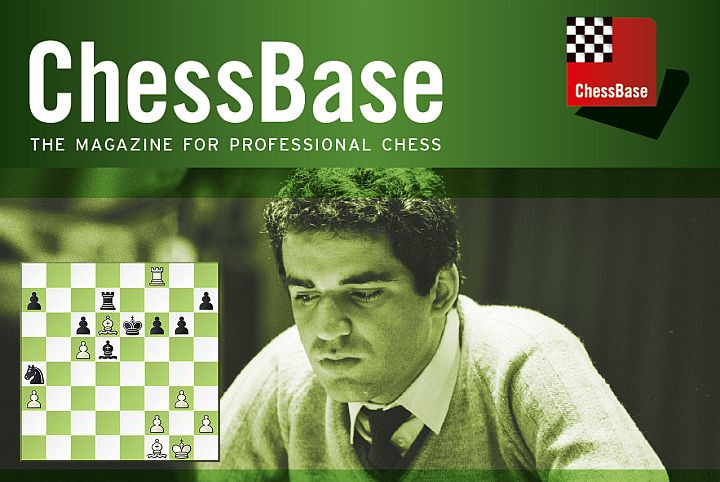The role of the bishop pair on Kasparov's way to the first WCh match
by Karsten Müller
From the start Garry Kasparov played very dynamic chess. Whenever he had activity and the initiative, almost no opponent could resist his pressure for long. It is very possible to examine various dynamic themes with the help of his early games. I have opted for the bishop pair and would like to explain some of the theory surrounding it through early Kasparov games. The bishop pair is more than just bishop + bishop, because one bishop is compensating for the main weakness of the other, its colour blindness. Consequently the bishop pair is a strong weapon in the endgame specifically in the hands of Garry Kasparov.
A) The swarm of mosquitos
An image which is often used is that of a swarm of mosquitos. Because the opponent's pieces have nowhere where they can be absolutely safe from the bishops. Often even rooks have problems with this:
In Kasparov,G - Smyslov,V (1984) Black is lost. What did Kasparov play? "Solutions" on the bottom of this article
B) The green bishop
When the bishop pair is facing a bishop and knight the bishop which has no counterpart can, according to Holger Borchers, also be described as a green bishop. The hopes of the bishop pair rest on it and the rule of thumb is as follows: the green bishop should be made as strong as possible.
How did White continue in Kasparov,G - Gligoric,S (1982)? Solution below.
In the following case the green bishop is extremely strong because the dark squares in Black's camp are very weak. In addition, the mobile white pawn majority on the kingside is an important factor; supported by the bishops it can simply roll forward.
In Kasparov,G - Smyslov,V (1984) White is clearly better. The position can hardly be held over the board, especially as it is much more simple for White to play because he has a clear plan.
C) Dynamism often help the bishops
A good rule of thumb is that bishops prefer dynamism in the position and knights prefer it to be static:
In Smyslov,V - Kasparov,G (1984) should White play 26.Kf2 or 26.R6c5?
Exchanging the bishop pair against a strategic initiative with 16.Bxb4 in Kortschnoj,V - Kasparov,G )1983) is playable because White's structure suits that plan. If White manages to get something on the queenside then Black can start to feel somewhat cramped. But the dynamic potential of the black bishops should not be underestimated. Whenever they awake Black too can also quickly get winning chances.
D) The bishops do not always win
Black is slightly better because he has a dark-squared, strategic initiative on account of the dark-squared holes in the white camp, especially d4. In addition, White's light-squared bishop is potentially a bad bishop on account of the pawns on c4 and e4. What should White play in Danailov,S - Kasparov,G (1980) to limit the damage?
Solutions
1. Kasparov,G - Smyslov,V (1984): 33.Ba6! +- Planning a fatal mosquito bite!
2. Kasparov,G - Gligoric,S (1982); 22.f3! Kasparov cramps the black pieces in typical fashion. 22...Qc7 23.e4 +-
3. Smyslov,V - Kasparov,G (1984): 28.R6c5? The following opening of the position plays into the hands of the bishops. (After 28. Kf2 the position is more or less level.) 28...Qxe3+ 29.Qxe3 Rxe3 30.Rxd5 Rxf3 31.Be2 Re3
4. Danailov,S - Kasparov,G (1980): 14.Bxf6? After this Kasparov can mount a typical dark-squared counterplay.(14.Be3 was required in order after 14...Nfxe4 15.Nd2 b6 16.Nxe4 Nxe4 17.Bf3 Nf6 18.g3 to seek compensation for the pawn with the bishop pair.) 14...Bxf6 15.Bd3 a5 16.Rhe1 Re8 Kasparov relieves the bishop from the protection of the e5-pawn.
Karsten Müller's article with all the games and analyses can be found in the new ChessBase Magazine # 198 (November/December 2020). In addition, the endgame expert from Hamburg contributed three more articles to the current issue: "Endgame highlights", "Current rook endings" and "The duel between rook and bishop".

Single isssue: 19,95 € – annual subscription (6 issues) 99,70 €
Available for download (including booklet in pdf) or on DVD + booklet (Post).
Test ChessBase Magazine – win twice over
You have not yet read the ChessBase Magazine? No problem. We have something for you.
The annual subscription with 6 issues + ChessBase USB stick (128 GB) + the chance of exclusive live coaching with world-class trainers for only €99.90
The trial subscription with 3 issues + 3 months Premium Membership (33% cheaper) for only €39.90























